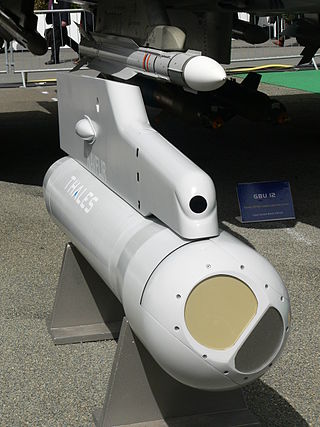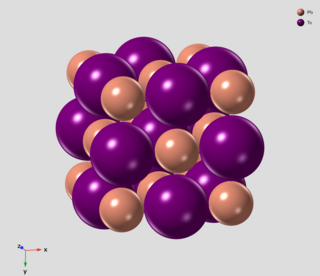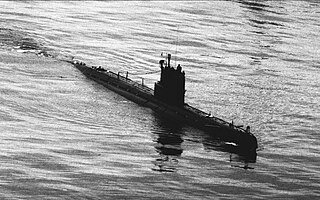Related Research Articles

Infrared is electromagnetic radiation (EMR) with wavelengths longer than that of visible light but shorter than microwaves. The infrared spectral band begins with waves that are just longer than those of red light, so IR is invisible to the human eye. IR is generally understood to include wavelengths from around 750 nm (400 THz) to 1 mm (300 GHz). IR is commonly divided between longer-wavelength thermal IR, emitted from terrestrial sources, and shorter-wavelength IR or near-IR, part of the solar spectrum. Longer IR wavelengths (30–100 μm) are sometimes included as part of the terahertz radiation band. Almost all black-body radiation from objects near room temperature is in the IR band. As a form of electromagnetic radiation, IR carries energy and momentum, exerts radiation pressure, and has properties corresponding to both those of a wave and of a particle, the photon.

A magnetic anomaly detector (MAD) is an instrument used to detect minute variations in the Earth's magnetic field. The term refers specifically to magnetometers used by military forces to detect submarines ; military MAD equipment is a descendant of geomagnetic survey or aeromagnetic survey instruments used to search for minerals by detecting their disturbance of the normal earth-field.

Forward-looking infrared (FLIR) cameras, typically used on military and civilian aircraft, use a thermographic camera that senses infrared radiation.

Infrared thermography (IRT), thermal video and/or thermal imaging, is a process where a thermal camera captures and creates an image of an object by using infrared radiation emitted from the object in a process, which are examples of infrared imaging science. Thermographic cameras usually detect radiation in the long-infrared range of the electromagnetic spectrum and produce images of that radiation, called thermograms. Since infrared radiation is emitted by all objects with a temperature above absolute zero according to the black body radiation law, thermography makes it possible to see one's environment with or without visible illumination. The amount of radiation emitted by an object increases with temperature; therefore, thermography allows one to see variations in temperature. When viewed through a thermal imaging camera, warm objects stand out well against cooler backgrounds; humans and other warm-blooded animals become easily visible against the environment, day or night. As a result, thermography is particularly useful to the military and other users of surveillance cameras.

An anti-submarine weapon (ASW) is any one of a number of devices that are intended to act against a submarine and its crew, to destroy (sink) the vessel or reduce its capability as a weapon of war. In its simplest sense, an anti-submarine weapon is usually a projectile, missile or bomb that is optimized to destroy submarines.

Infrared homing is a passive weapon guidance system which uses the infrared (IR) light emission from a target to track and follow it seamlessly. Missiles which use infrared seeking are often referred to as "heat-seekers" since infrared is radiated strongly by hot bodies. Many objects such as people, vehicle engines and aircraft generate and emit heat and so are especially visible in the infrared wavelengths of light compared to objects in the background.

A passive infrared sensor is an electronic sensor that measures infrared (IR) light radiating from objects in its field of view. They are most often used in PIR-based motion detectors. PIR sensors are commonly used in security alarms and automatic lighting applications.

Hg1−xCdxTe or mercury cadmium telluride is a chemical compound of cadmium telluride (CdTe) and mercury telluride (HgTe) with a tunable bandgap spanning the shortwave infrared to the very long wave infrared regions. The amount of cadmium (Cd) in the alloy can be chosen so as to tune the optical absorption of the material to the desired infrared wavelength. CdTe is a semiconductor with a bandgap of approximately 1.5 electronvolts (eV) at room temperature. HgTe is a semimetal, which means that its bandgap energy is zero. Mixing these two substances allows one to obtain any bandgap between 0 and 1.5 eV.

Anti-submarine warfare is a branch of underwater warfare that uses surface warships, aircraft, submarines, or other platforms, to find, track, and deter, damage, or destroy enemy submarines. Such operations are typically carried out to protect friendly shipping and coastal facilities from submarine attacks and to overcome blockades.
Lead selenide (PbSe), or lead(II) selenide, a selenide of lead, is a semiconductor material. It forms cubic crystals of the NaCl structure; it has a direct bandgap of 0.27 eV at room temperature. A grey solid, it is used for manufacture of infrared detectors for thermal imaging. The mineral clausthalite is a naturally occurring lead selenide.
The SPRITE infrared detector is named after the process of signal integration carried out by "Signal Processing In The Element". The technique was invented at the Royal Signals and Radar Establishment at Malvern by a team of scientists including Tom Elliott.

Lead telluride is a compound of lead and tellurium (PbTe). It crystallizes in the NaCl crystal structure with Pb atoms occupying the cation and Te forming the anionic lattice. It is a narrow gap semiconductor with a band gap of 0.32 eV. It occurs naturally as the mineral altaite.

An infrared countermeasure (IRCM) is a device designed to protect aircraft from infrared homing missiles by confusing the missiles' infrared guidance system so that they miss their target. Heat-seeking missiles were responsible for about 80% of air losses in Operation Desert Storm. The most common method of infrared countermeasure is deploying flares, as the heat produced by the flares creates hundreds of targets for the missile.

HMS Sea Devil was a S-class submarine of the third batch built for the Royal Navy during World War II. She survived the war and was sold for scrap in 1966.

A submarine snorkel is a device which allows a submarine to operate submerged while still taking in air from above the surface. British Royal Navy personnel often refer to it as the snort. A concept devised by Dutch engineers, it was widely used on German U-boats during the last year of World War II and known to them as a schnorchel.
Electro-optical MASINT is a subdiscipline of Measurement and Signature Intelligence, (MASINT) and refers to intelligence gathering activities which bring together disparate elements that do not fit within the definitions of Signals Intelligence (SIGINT), Imagery Intelligence (IMINT), or Human Intelligence (HUMINT).
Infrared signature, as used by defense scientists and the military, is the appearance of objects to infrared sensors. An infrared signature depends on many factors, including the shape and size of the object, temperature, and emissivity, reflection of external sources from the object's surface, the background against which it is viewed and the waveband of the detecting sensor. As such there is no all-encompassing definition of infrared signature nor any trivial means of measuring it. For example, the infrared signature of a truck viewed against a field will vary significantly with changing weather, time of day and engine loading.

Infrared and thermal testing refer to passive thermographic inspection techniques, a class of nondestructive testing designated by the American Society for Nondestructive Testing (ASNT). Infrared thermography is the science of measuring and mapping surface temperatures.
"Infrared thermography, a nondestructive, remote sensing technique, has proved to be an effective, convenient, and economical method of testing concrete. It can detect internal voids, delaminations, and cracks in concrete structures such as bridge decks, highway pavements, garage floors, parking lot pavements, and building walls. As a testing technique, some of its most important qualities are that (1) it is accurate; (2) it is repeatable; (3) it need not inconvenience the public; and (4) it is economical."

Autolycus or Sniffer was a submarine detection system designed to detect diesel-engined submarines from aircraft. It was designed to detect exhaust fumes from their diesel engines. Named after the mythical Greek, Autolycus, who took part in the search for the Golden Fleece, it was developed by the British during the early Cold War period. The first version of Autolycus was deployed on Avro Shackleton aircraft in the mid-1950s, with an improved version re-appearing in the mid-1960s.
References
- ↑ WD484 was lost on 2 March 1955 with two fatalities in a take-off accident from RAF Boscombe Down, when the elevator locks were left engaged. [3]
- ↑ This "line scan" motion gave the later infrared linescan systems their name
- 1 2 3 4 5 6 7 8 9 10 11 12 Gibson, Chris (2015). Nimrod's Genesis. Hikoki Publications. pp. 25–26. ISBN 978-190210947-3.
- ↑ Jones, R.V. (1978). Most Secret War.
- ↑ "Handley Page Hastings C.2 WD484". Aviation Safety Network.
- ↑ "Infra-Red Committee: field trials of Yellow Duckling equipment". The National Archives, Kew. 1954. AC 13351 / WO 195/13347.
- ↑ Gibson (2015), p. 203.
- ↑ Gibson (2015), pp. 116–117.
- ↑ Gibson (2015), pp. 114–115.
- ↑ Air Staff Target OR.350, 18 July 1960
- ↑ Gibson (2015), pp. 161–162.